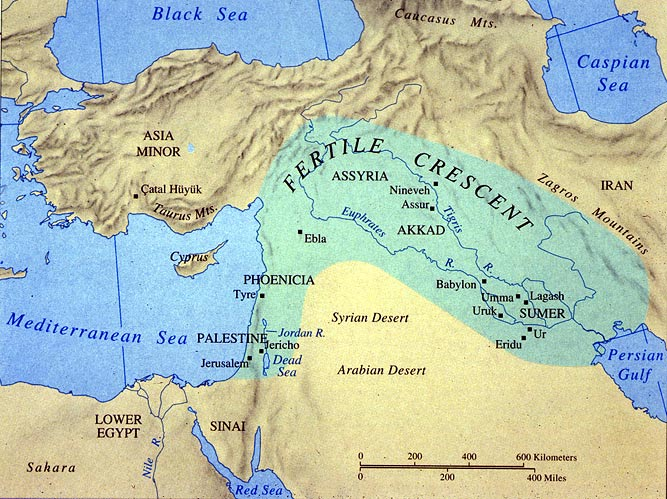

Spatial
Distribution Animal
Domestication Plant
Domestication Food
Production
currently, earliest evidence of domesticates is in nuclear zones
(where
progenitors were found) of Near East, supporting Braidwood's
experimentation or hilly flanks theory rather than Childe's oasis theory
food production developed independently in three different Near East subhearths initially:
1. Levant - Israel, Jordan, Sinai, western Syriaafter 5000 BC, the three subhearth areas exchanged ideas and productions of food production along existing trade routes
2. Mesopotamia and Zagros Mountains - Iran, Iraq, eastern Syria
3. Anatolia - Turkey

TRENDS
important domesticates were *sheep, *goat, cattle, dog, pig, donkey, horse, camel
probably began before plant domestication; was a long process
began in many parts of Near East about the
same time (9000-6000 BC)
first herd domesticate was sheep, about
8900 BC
required new tools like pens
SPECIES
first domesticate was dog
oldest bones are 11,000 BC from Palegawra Cave, north Iraq; may be as early as 22,000 BC?first herd domesticate was sheep
domesticated to aid in hunting or to protect herds?
at Zawi Chemi Shanidar site is evidence of possible sheep herding and probably domestication at about 8900 BC; evidence is selective slaughtering indicated by age distribution of bones (or selective hunting?)another early herd domesticate was goats
in Jordan Valley at about 8500 BC
herding well established in Zagros Mtns by 8000 BC
wool industry probably not until 4000 BC
sheep provided meat, milk and wool
Sheep herding.
first evidence of domesticated goats is in Zagros area of Iran at about 7500 BC (Tel Asiab) and in lower Mesopotamia at Ali Kosh (72% of animal bone is goats) and Ganj Darehcattle probably domesticated in several areas
goats and sheep in Levant by 7000 BC
sheep and goats all over by 6000 BC
goats provided meat and milk
Domesticated goats.
first evidence of domesticated cattle in southeastern Europe (another hearth outside Near East) about 7000 BCpigs were also domesticated
domesticated forms in Anatolia about 6500 BC and make up major percentage of animal diet at Catal Hüyük by 6000 BC
important because provided meat, milk, hides, labor
first evidence of domesticated pigs about 6000-7000 BC but were never a major food source
early evidence in Anatolia at about 7000 BC
by 6000 BC pig remains are 20-30% of diet at many large sites
after 2400 BC pig use declines sharply due to religious beliefs
not as desirable as sheep, goats, and cattle, which can digest cellulose foods humans can't, but pigs may have been kept for dietary variety and can eat human refuse
TRENDS
important domesticates were *wheat, *barley, legumes (peas, lentils, chickpeas, bitter vetch), nuts (almond, pistachio, oak/acorn), fruits (olives, grapes, dates, figs)
first possible cultigens are grasses at Shanidar site dated to 9000
BC
definite domesticated forms of wheat and barley as early as 8400 BC
domesticated plants used extensively on Mesopotamian floodplain before Zagros Mtns
domesticated plants throughout Levant about 8000 BC

Wild grasses, some species of which
became domesticated.
SPECIES
wheat was first domesticated grain crop
first evidence of domesticated wheat in Levantbarley was another early grain crop
Jericho by 8400-7400 BC (may have come from Jordan)
wheat appears in Syria by about 8000 BC
wheat varieties include einkorn (bread) and emmer
Varieties of domesticated wheat:
einkorn, emmer.
Domesticated emmer wheat.
first evidence of domesticated barley in Levant and Mesopotamiadomesticated legumes are difficult to identify archaeologically
tough-axis barley at Jericho by 8400-7400 BC (from Jordan?)
tough-axis barley at Beidha in Levant at about 7000 BC
tough-axis barley at Ali Kosh in lower Mesopotamia at about 7000 BC
six-rowed barley at Ali Kosh by about 6000 BC
Grains of domesticated barley.
peas probably domesticated in open oak forest areas of Near Eastfruits were added to farming complex between 2000-3000 BC
first evidence of lentils in Anatolia by 7000 BC
chickpeas probably domesticated in Levant and southeast Turkey
bitter vetch probably in Anatolia, probably only a backup food
olives, grapes and figs probably domesticated in Anatolia or Levant
dates probably domesticated in lower Mesopotamia during Jemdet Nasr Period
orchards about 3000 BC
GENERAL TRENDS
general trend was early villages --> domestication --> advanced sedentism --> food production
there is an important difference between domesticating plants and animals and food production, or coming to rely on them for majority of one's diet; transition took several thousand years
in general, established village farming widespread by 6500-5000 BC
LEVANT AREA
early emphasis was on sedentism instead of food production, cattle over sheep/goats
stock breeding provides 60% of diet in Levant by 6500 BC
farming quite variable throughout Levant by 6000 BC
village farming/herding sites in Levant included Abu Hureyra (southern Syria), where farming dominated by 7500-5000 BC
ZAGROS / MESOPOTAMIA AREA
early emphasis on food production instead of sedentism, sheep and goats over cattle
farming earlier in lowlands; herding earlier in mountains
village farming/herding sites in Mesopotamia/Zagros:
1. Tel Mureybit (Syria)ANATOLIA
one of earliest agricultural settlements in Near East
village farming by 8000 BC, mostly wheat and barley2. Ali Kosh (Mesopotamia)
village by 8000 BC
farming and herding tradition for 2000 years
3. Ganj Dareh (Zagros)
7000 BC goat and cattle herding well established
4. Jarmo (Zagros)
long occupation but village by 5000 BC
farming and herding made up 80% of the diet
farming and herding begins about 7500 BC
regular cattle herding by 5800 BC
village sites in Anatolia:
1. Cayönü
by 6700 BC increased reliance on domesticates, esp. sheep, grains2. Hacilar
village by 6500 BC; evidence of dog and grain use
3. Catal Hüyük
village by 6500-6000 BC
cattle important as evidenced by fertility shrines
Redman, Charles L.
1978 The Rise of Civilization. W.H. Freeman, San
Fransisco.